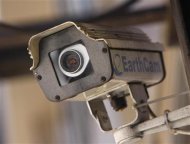Nation's food anti-terror plans costly, unwieldy
 By GARANCE BURKE - Associated Press | AP – 3 hrs ago
By GARANCE BURKE - Associated Press | AP – 3 hrs agoSAN FRANCISCO (AP) — One of the deepest fears sweeping a shattered nation following the Sept. 11 attacks was that terrorists might poison the country's food.
Hoping to ease people's anxieties about what they were eating, President George W. Bush vowed to draw a protective shield around the food supply and defend it from farm to fork.
An Associated Press analysis of the programs found that the government has spent at least $3.4 billion on food counter-terrorism in the last decade, but key programs have been bogged down in a huge, multi-headed bureaucracy. And with no single agency in charge, officials acknowledge it's impossible to measure whether orchards or feedlots are actually any safer.
On Tuesday, a Senate subcommittee will hold a hearing to examine a congressional watchdog's new report revealing federal setbacks in protecting cattle and crops since Sept. 11. Just days after the 10th anniversary of the attacks, lawmakers are demanding answers about potential food-related threats and reports that the government could have wasted money on languishing agriculture anti-terror programs.
"The truth is, nobody's in charge," said John Hoffman, a former senior adviser for bio-surveillance and food defense at the Department of Homeland Security, who will testify at the hearing. "Our surveillance doesn't work yet, our intelligence doesn't work yet and we're not doing so well at targeting what comes across the border."
Top U.S. food defense authorities insist that the initiatives have made the food supply safer and say extensive investments have prepared the country to respond to emergencies. No terrorist group has threatened the food supply in the past decade, and the largest food poisonings have not arisen from foreign attacks, but from salmonella-tainted eggs produced on Iowa farms that sickened almost 2,000 people.
Seeking to chart the government's advances, the AP interviewed dozens of current and former state and federal officials and analyzed spending and program records for major food defense initiatives, and found:
— The fragmented system leaves no single agency accountable, at times slowing progress and blurring the lines of responsibility. Federal auditors found one Agriculture Department surveillance program to test for chemical, biological, and radiological agents was not working properly five years after its inception in part because agencies couldn't agree on who was in control.
— Efforts to move an aging animal disease lab from an island near New York City have stalled after leading scientists found an accidental release of foot-and-mouth was likely to happen at the new facility in America's beef belt.
— Congress is questioning whether $31 million the Department of Homeland Security spent to create a state-of-the-art database to monitor the food supply has accomplished anything because agencies are not using it to share information.
— Despite the billions spent on food defense, many of the changes the government put into place are recommendations that the private sector isn't required to carry out. As a result, it's difficult to track successes and failures, and the system's accomplishments are largely hidden from public view.
"Everything that has been done to date on food defense in the private sector has all been voluntary," said LeeAnne Jackson, the Food and Drug Administration's health science policy advisor. "We can't go out and ask them what they have done, because they're not obliged to tell us, so we don't have a good metric to measure what's been done."
The food defense effort shifted into high gear in 2004 when Bush directed the government to create new systems to guard against terrorist attacks. Agencies got money to assess risks, contain foreign disease outbreaks and help farms and food processing plants develop protection programs.
The newly established Department of Homeland Security, which was charged with sharing information about federal food defense plans, also distributed grants among agencies, contractors and universities. During the past nine years, it spent $467 million on food-related research alone.
A $6 million counter-terrorism network headquartered in Iowa that helps veterinarians stop viruses from spreading between herds is considered one of the successes. Another is a program that gave California dairymen hundreds of thousands of dollars to buy high-tech locks for their milking barns.
The department also spent $550 million to run its Office of Health Affairs, which coordinates bio-surveillance across federal agencies. In fiscal year 2008, that office set out to build a new database where food, agriculture, disease and environmental agencies could view each other's surveillance information in real time.
But Jeff Runge, DHS's former chief medical officer, said the other agencies did not want to hand over their data, and turf battles delayed the government's progress in pinpointing a culprit as hundreds of people fell ill during a nationwide salmonella outbreak tied to peppers that summer.
"FDA was going on its own track, DHS was on its track, and no one was talking to each other," said David Acheson, who was then FDA's assistant commissioner and is now a food industry consultant.
In June, Democratic Rep. Bill Pascrell of New Jersey introduced a bill that would eliminate the database. The Republican-led House Appropriations Committee also has questioned what Homeland Security has accomplished after spending $31 million running the program.
"It just didn't work," said Runge, who oversaw the database. "Now Al Qaeda is headed by a physician who has expressed interest in biological attacks, and I don't think we are putting enough brain cycles on this issue."
The department is working to integrate data across federal agencies, and is trying to enhance the database's effectiveness by reviewing the "challenges and opportunities of integrated bio-surveillance," a DHS official said.
FDA and USDA have handled much of the on-the-ground work with farmers, ranchers and manufacturing plants.
FDA has spent $1.3 billion on food defense programs since 2005, the most recent year available, said spokeswoman Patricia El-Hinnawy. The USDA said it has spent $1.64 billion on food defense since 2003.
One top priority was setting up an animal identification system to track infected livestock. Agriculture Secretary Tom Vilsack recently proposed a new system that would work whether animals were infected by accident or by terrorists.
A separate project to integrate the nation's food testing laboratories has foundered, however, auditors found in February.
Five years after its creation, the Food Emergency Response Network has not set up a targeted surveillance program to test for chemical, biological, and radiological agents, and USDA and FDA still can't agree on who runs it, USDA's Office of Inspector General found.
Protecting the food supply remains a top priority, and USDA continues working to advance its efforts, said Sheryl Maddux, deputy director of its Office of Homeland Security and Emergency Coordination.
Some small farmers claim some of USDA's rules have become so unwieldy in the last decade they threaten business.
Under agency guidance issued since Sept. 11, USDA inspectors have strongly encouraged slaughterhouses and other facilities they regulate to write Food Defense Plans, and now nearly three-quarters have them.
Uli Bennewitz, who owns a small farm-brewery-butchery near the Outer Banks in Jarvisburg, N.C., and wins national foodie awards for his artisan sausages, says he had to hire one of his three employees just to deal with the on-site meat inspector. He says the federal involvement lacks common sense.
"When it comes to treating a Tyson chicken plant the same as a one-man brewery butchery, that's when these laws get completely out of control," Bennewitz said. "What is a small farm doing writing a Food Defense Plan? That is not going to save the nation from some terrible disease."
That's where upgrading the nation's primary animal disease laboratory comes in, federal officials say. The facility, which does crucial research on foot-and-mouth disease, is currently housed on a tiny island 100 miles east of New York City.
DHS spent $233 million running the lab in the past few years and plans to move the operations to Manhattan, Kan., by 2018.
But a National Research Council report issued last year cited safety concerns with the Kansas location, including a 70 percent chance that dangerous pathogens could be released close to urban populations and cattle yards over the project's 50-year life.
Many ranchers oppose the move because of the proximity to the beef belt, but DHS officials have said the lab will be safe, and say the report failed to consider safety measures that will be added during construction.
One food defense program has had particularly tangible results in the nation's No. 1 dairy state. California agriculture officials distributed about $400,000 in DHS grants to keep the milk supply safe, including new locks for milk houses.
"We're so remote out here, security isn't much of an issue, but we were happy to do an upgrade on the farm," said John Taylor, who got about $800 for a lock at his organic dairy in Marin County. "At this point there is no way to get in there unless you know the key sequence. Now I have that peace of mind."
Comments from Doozler
Speaking of food safety, maybe Washington can explain why the U.S. has the most lax regulations regarding genetically modified foods in the industrialized world. Restrictions in the U. K, Europe and Japan are much tougher. And then the President should explain how a former Monsanto VP and lobbyist became his food czar at the Food and Drug Administration.
The defence industry sets military policy in the U. S; health insurers set health policy and Wall Street sets financial policy. Why would we expect anything less than corporate control of the food sector?
___
























